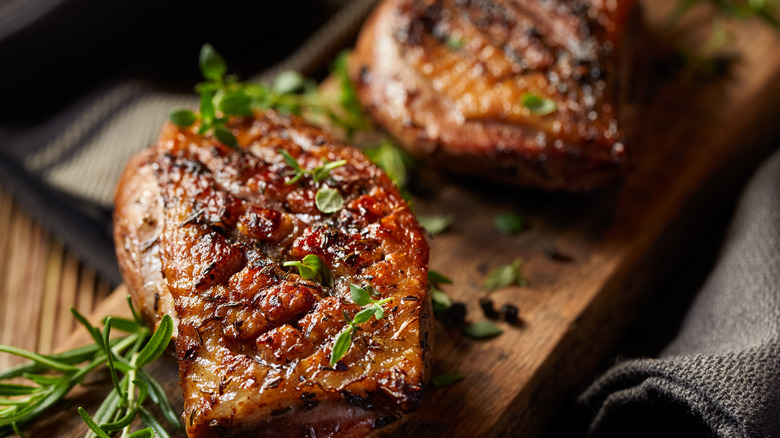Thomas Keller's Method For Perfect Seared Duck Breast
Blood sausage, escargot, and foie gras — these are the luxury foods you told us you're least likely to try. But, duck breast? You know you love it. Still, the first time you ordered it in a fancy restaurant and it came to the table slightly on the rare side, chances are good an undeserving fear of salmonella pulled up a seat beside you. However, because a duck's diet and digestive system differs from a chicken's, Eat Pallet explains that you can enjoy the rare delicacy fearlessly.
And, if you've had the rare opportunity to savor duck breast at one of Thomas Keller's Michelin-starred restaurants, you know its succulence firsthand. "We like to serve our duck breasts medium-rare," Chef Keller told MasterClass. "It's the most tender at that stage. Rare is a little chewy. [If] it gets above medium, it starts to taste a little livery."
Served medium-rare reflects its most moist qualities, which vary from that of chicken due to the duck's higher fat content, notes Eat Pallet. But, try as you may to crisp up the skin at a Keller level of perfection, the task might prove a bit tenuous. So, take it from an expert: Chef Keller pan-roasts his version of the classic French dish duck à l'Orange.
The Keller Method
While pan-roasting is a bit more time consuming than sautéeing, MasterClass points out that Keller's method starts with rinsing and patting dry the boneless, skin-on duck breast. He then air-dries it in the refrigerator for three days, skin up, thereby removing the excess moisture and allowing a crisper end-product. When he's ready to cook the breast, he tempers it by bringing it to room temperature, piercing the skin for a faster fat rendering process. You can opt to score the skin, but Keller cautions to avoid piercing the actual meat.
The outlet further explains that he drizzles a bit of canola oil in a sauté pan over medium heat, before laying each breast skin-down in the pan. You'll notice a slight sizzle with this process, so Keller notes to give the pan a short shake to avoid the breasts from sticking, and go slow. "Gentle cooking is the ticket for pan-roasting," Keller told MasterClass. Wherever the skin isn't contacting the pan, he advises to press down with a palette knife. When you're about 80% there, he adds to baste with the rendered fat before flipping the breast for a quick "kiss" of the flesh side to the heat just enough to give it some color. Finish by letting it rest on a rack or paper towel-lined pan for five minutes prior to serving.
And, there you have it — perfectly seared duck breast in the way of chef Thomas Keller.

